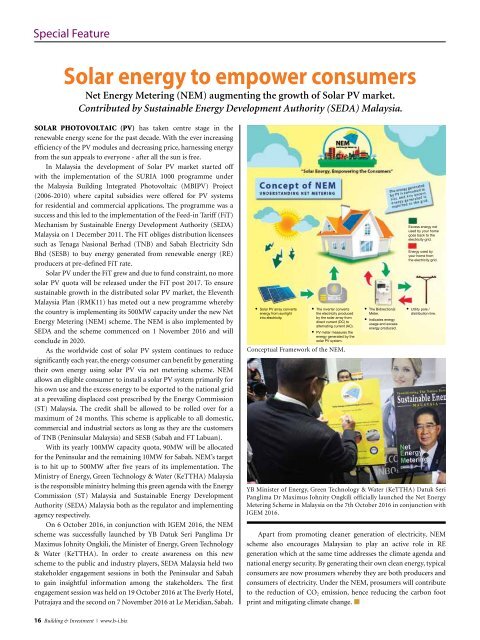Create successful ePaper yourself
Turn your PDF publications into a flip-book with our unique Google optimized e-Paper software.
Special Feature<br />
Solar energy to empower consumers<br />
Net Energy Metering (NEM) augmenting the growth of Solar PV market.<br />
Contributed by Sustainable Energy Development Authority (SEDA) Malaysia.<br />
SOLAR PHOTOVOLTAIC (PV) has taken centre stage in the<br />
renewable energy scene for the past decade. With the ever increasing<br />
efficiency of the PV modules and decreasing price, harnessing energy<br />
from the sun appeals to everyone - after all the sun is free.<br />
In Malaysia the development of Solar PV market started off<br />
with the implementation of the SURIA 1000 programme under<br />
the Malaysia <strong>Building</strong> Integrated Photovoltaic (MBIPV) Project<br />
(2006-2010) where capital subsidies were offered for PV systems<br />
for residential and commercial applications. The programme was a<br />
success and this led to the implementation of the Feed-in Tariff (FiT)<br />
Mechanism by Sustainable Energy Development Authority (SEDA)<br />
Malaysia on 1 December 2011. The FiT obliges distribution licensees<br />
such as Tenaga Nasional Berhad (TNB) and Sabah Electricity Sdn<br />
Bhd (SESB) to buy energy generated from renewable energy (RE)<br />
producers at pre-defined FiT rate.<br />
Solar PV under the FiT grew and due to fund constraint, no more<br />
solar PV quota will be released under the FiT post <strong>2017</strong>. To ensure<br />
sustainable growth in the distributed solar PV market, the Eleventh<br />
Malaysia Plan (RMK11) has meted out a new programme whereby<br />
the country is implementing its 500MW capacity under the new Net<br />
Energy Metering (NEM) scheme. The NEM is also implemented by<br />
SEDA and the scheme commenced on 1 November 2016 and will<br />
conclude in 2020.<br />
As the worldwide cost of solar PV system continues to reduce<br />
significantly each year, the energy consumer can benefit by generating<br />
their own energy using solar PV via net metering scheme. NEM<br />
allows an eligible consumer to install a solar PV system primarily for<br />
his own use and the excess energy to be exported to the national grid<br />
at a prevailing displaced cost prescribed by the Energy Commission<br />
(ST) Malaysia. The credit shall be allowed to be rolled over for a<br />
maximum of 24 months. This scheme is applicable to all domestic,<br />
commercial and industrial sectors as long as they are the customers<br />
of TNB (Peninsular Malaysia) and SESB (Sabah and FT Labuan).<br />
With its yearly 100MW capacity quota, 90MW will be allocated<br />
for the Peninsular and the remaining 10MW for Sabah. NEM’s target<br />
is to hit up to 500MW after five years of its implementation. The<br />
Ministry of Energy, Green Technology & Water (KeTTHA) Malaysia<br />
is the responsible ministry helming this green agenda with the Energy<br />
Commission (ST) Malaysia and Sustainable Energy Development<br />
Authority (SEDA) Malaysia both as the regulator and implementing<br />
agency respectively.<br />
On 6 October 2016, in conjunction with IGEM 2016, the NEM<br />
scheme was successfully launched by YB Datuk Seri Panglima Dr<br />
Maximus Johnity Ongkili, the Minister of Energy, Green Technology<br />
& Water (KeTTHA). In order to create awareness on this new<br />
scheme to the public and industry players, SEDA Malaysia held two<br />
stakeholder engagement sessions in both the Peninsular and Sabah<br />
to gain insightful information among the stakeholders. The first<br />
engagement session was held on 19 October 2016 at The Everly Hotel,<br />
Putrajaya and the second on 7 November 2016 at Le Meridian, Sabah.<br />
Solar PV array converts<br />
energy from sunlight<br />
into electricity.<br />
The inverter converts<br />
the electricity produced<br />
by the solar array from<br />
direct current (DC) to<br />
alternating current (AC).<br />
PV meter measures the<br />
energy generated by the<br />
solar PV system.<br />
Conceptual Framework of the NEM.<br />
The Bidirectional<br />
Meter.<br />
Indicates energy<br />
usage and excess<br />
energy produced.<br />
Excess energy not<br />
used by your home<br />
goes back to the<br />
electricity grid.<br />
Energy used by<br />
your home from<br />
the electricity grid.<br />
Utility pole /<br />
distribution line.<br />
YB Minister of Energy, Green Technology & Water (KeTTHA) Datuk Seri<br />
Panglima Dr Maximus Johnity Ongkili officially launched the Net Energy<br />
Metering Scheme in Malaysia on the 7th October 2016 in conjunction with<br />
IGEM 2016.<br />
Apart from promoting cleaner generation of electricity, NEM<br />
scheme also encourages Malaysian to play an active role in RE<br />
generation which at the same time addresses the climate agenda and<br />
national energy security. By generating their own clean energy, typical<br />
consumers are now prosumers whereby they are both producers and<br />
consumers of electricity. Under the NEM, prosumers will contribute<br />
to the reduction of CO 2 emission, hence reducing the carbon foot<br />
print and mitigating climate change. <br />
16 <strong>Building</strong> & <strong>Investment</strong> | www.b-i.biz


















